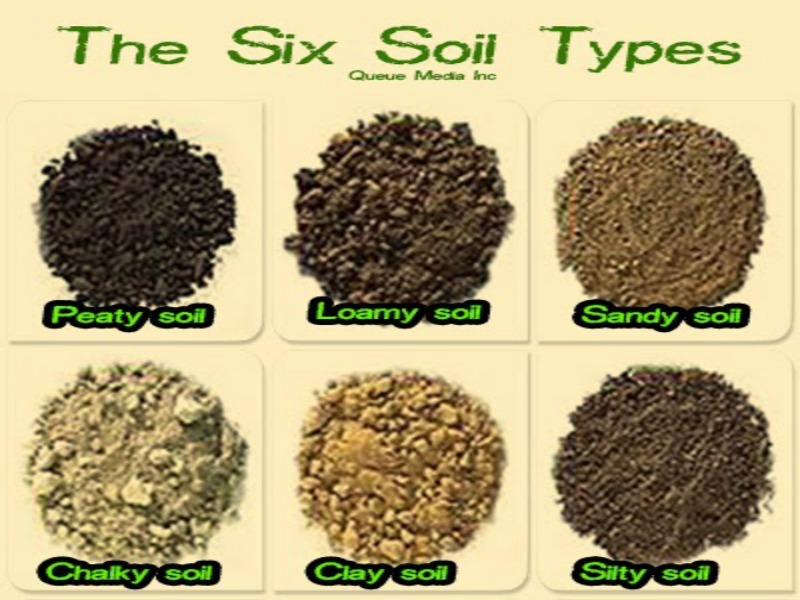
Did you know there are different types of soil? There are six main varieties, and while lots of soil is a mixture of some of these, all dirt falls into one primary category. Understanding your soil type helps you know what kind of plants will do well on your earth and what amendments your garden may need.
The soil might not seem like it’s that important but Soil provides your plants with all of the vital nutrients, air, and water that they need to grow and thrive. Soil is like your diet- if you eat food that isn’t nutritious, you won’t be as healthy as you could be. If your plants aren’t growing in the right soil, they won’t be healthy. The soil in your garden beds is the lifeblood of your plants. It took me some time to understand that.
Soil doesn’t come in a one-size-fits-all type. It varies by region, and even property by property. You don’t have to live with the soil in your garden. You can create different soil conditions in raised beds, planters, or larger garden plots. It’s essential to understand the characteristics of your soil to maximize your garden health. The 6 Types of Soil are described here.
Peaty Soil
Peat soil has a dark colour, and when it’s wet, it feels damp and spongy. There are some advantages to having peaty soil. It’s acidic and helps to slow down decomposition, but that can cause the ground to have fewer nutrients available for the plants. Peaty soil heats up quickly during the spring, but it retains a lot of water, so it might have drainage issues.
If your garden beds have peaty soil, you might have to dig drainage channels to help the water drain out. On the bright side, peat soil, when mixed with compost and other organic matter, is excellent for plant growth. You can add lime to reduce the acidic nature.
- Pros: Peaty soil is rich in nutrients, which makes it great for plant growth. It also heats up quickly.
- Cons: Peat is highly acidic and retains a lot of water.
Plant Thrives in Peat Soil
- Root Crops
- Salad Greens
- Brassicas
- Lantern Trees
- Witch Hazel
Plant Struggles in Peat Soil
- Tomatoes
- Peppers
Loamy
The first type of soil is loamy soil, which is like a mixture of clay, silt, and sand. When you hold it in your hands, it has a fine texture and might feel a bit damp. Loamy soil is ideal for many gardens, lawns, and shrubs, so pat yourself on the back if you have this type of soil in your gardens.
Overall, loamy soil has a great structure for planting, it has a good amount of drainage, it retains moisture, and it holds nutrients fairly well. That said, its drainage properties mean that nutrients wash out and you will need to add nutrients back into the soil, so add compost often. Also, loamy soil tends to be acidic.
- Pros: Loamy soil has a great structure and drains well. It also holds nutrients well, though they can wash out at a moderate rate.
- Cons: Loamy soil is acidic, and you’ll need to add nutrients to help plants thrive.
Plant Thrives in Loamy Soil
- Climbers
- Vegetables
- Berries
- Root Crops
Plant Struggles in Loamy Soil
- Tomatoes, after the seedling stage
- Green Beans
- Late-growing cabbage and brassicas
- Cacti
Sandy Soil
If you hold sandy soil in your hands, it feels gritty. The benefit of sandy soil is that it drains quickly and dries out fast. Not all plants like this, of course, but those that do will be happy. In the spring, sandy soil warms up quickly, but it doesn’t hold onto nutrients as long because they wash away during wetter spells.
Sandy soil often requires some organic amendments like organic fertilizer blends, glacial rock dust, or kelp meal. Also, you’ll want to add mulch to gardens with sandy soil because it helps to retain moisture.
- Pros: Sandy soil drains well and warms up fast. It’s ideal for seedlings and it’s easy to dig in.
- Cons: Nutrients drain away quickly in sandy soil. It’s not as fertile as other types, and it dries out quickly.
Plant Thrives in Sandy Soil
- Vegetable root crops, such as carrots, potatoes, and parsnips
- Lettuce
- Strawberries
- Corn
- Squash
Plant Struggles in Sandy Soil
- Cabbage
- Broccoli
- Peas
Chalky Soil
When compared to other soils, chalky soil has larger grains and a stony feel. Usually, it overlays limestone bedrock or chalk, so it’s free draining. Chalky soil is alkaline, so it can cause your plants to experience stunted growth, as well as yellowish leaves.
You can change chalky soil, but it takes some work, like adding organic fertilizers and balancing the pH levels. You can add humus to the ground to help improve water retention and to improve the workability of the soil.
- Pros: Chalky soil is a champion at draining well. It’s also easy to work.
- Cons: Chalky soil is alkaline, so plants that need acid soil won’t do well. It also leaches out iron and magnesium.
Plant Thrives in Chalky Soil
- Spinach
- Beets
- Sweet Corn
- Cabbage
- Lilacs
Plant Struggles in Chalky Soil
- Blueberries
- Tomatoes
Clay Soil
Clay is one of the easiest types of soil to distinguish. It feels lumpy when you hold it in your hand and sticky when it’s wet. When clay soil is dry, it’s as hard as a rock.
The biggest problem with clay soil is that it’s horrible at draining and doesn’t have any air pockets. Imagine moulding clay; it’s thick and dense. That’s what clay soil is like. Also, clay earth takes time to warm up in the spring, and it’s difficult to cultivate.
On the positive side, if gardeners enhance the drainage of the soil, then clay soil is fantastic for growing because it provides plenty of nutrients to the plants.
- Pros: Water doesn’t drain as fast as other types of soil.
- Cons: Soil can become waterlogged, and it takes time to warm up. It’s also harder to dig in.
The plant thrives in clay soil
- Summer crop vegetables
- Fruit trees
- Ornamental trees
- Perennials
- Aster
- Bergamot
Plant struggles in clay soil
- Carrots
- Parsnips
- Soft berries
Silty Soil
Silty Soil feels soft in your hands, almost like soap. It holds moisture well, so it’s generally rich in nutrients. Gardeners love silty soil because it’s easily cultivated, but it can become compacted, so it poses problems for root crops.
Mixing silty soil with other types of soil, such as clay, can help to increase drainage. If silty soil drains too much, mixing in composted organic matter can provide structure.
- Pros: Silty soil holds moisture well and is rich in nutrients.
- Cons: It compacts easily and can get waterlogged.
Plant Thrives in Silty Soil
A lot of plants grow well in silty soil. Such as
- Most veggie crops
- Climbers
- Perennial plants
- Willow Trees
- Birch Trees
- Dogwood Trees
Plant Struggles in Silty Soil
- Carrots
- Parsnips
Testing of Soil
You can figure out what type of soil you have by looking at the texture of your soil when it’s wet and dry. Take a small amount of earth in your hand and wet it. Then, knead it into a paste and roll it out between your palms to form a ball.
Then, look at the characteristics of that ball to determine what type of soil you have.
- Clay soil: Rolls into a ball easily, but might feel rough or have a shiny look on the exterior.
- Sandy soil: Rolls into a ball without problems but feels gritty, OR doesn’t roll into a ball well and feels gritty.
- Loamy soil: Feels sticky and gritty, which is the indication of the perfect earth. If mixed with sand, it might fall apart.
- Silty soil: It feels slippery and silky but rolls into a ball with some work.
- Peaty soil Rolls into a ball but breaks apart easily. Feels a bit like a sponge.
- Chalky soil: Doesn’t roll too well and has a dry texture.
How to Amend the Soil
No matter what type of soil you have, it’s possible to amend and adjust the soil to make it fit your needs. Raised beds are ideal in situations that have problematic soil; you can control the environment better with raised beds. If you don’t want to create raised beds, here are some solutions for your soil.
Adjust the pH Level
Most plants prefer neutral soil, but some favour slightly acid or alkaline soils. Adjusting the levels help make the soil more hospitable to the plants you want to grow.
- To make the soil more alkaline, add ground lime.
- To make the soil more acidic, add aluminium sulfate or sulfur.
Adding Nutrients
Some soils, such as sandy soil, lose their nutrients quickly, so you need to add more. Organic matter, like compost and rotted manure, enriches the ground while also improving the texture. In the case of sandy soil, adding compost makes the soil hold onto moisture longer.
You also can use organic mulches, like grass clippings and shredded leaves. Organic mulches break down over time, sending nutrients into the soil and improving the soil structure.
Increasing Drainage
If your soil is holding onto too much water, you must increase drainage. Some gardeners add compost or sand to the earth to help it drain better. Mixing soil types can create an ideal situation.
Retaining More Moisture
On the other hand, sometimes soil drains too quickly, so you need to help it retain moisture. One way to do that is by using organic mulches around your plants. Not only does mulch help to retain moisture, but it will change the soil structure. You can also add peat moss or compost to help retain moisture.
Know Your Types of Soil
The type of soil that you have is more than boring old dirt. It can determine the success or failure of your garden. By learning how to adjust your soil to make it the right one for your plants, you give your plants the best start and chance to thrive.
Study and tend to your soil just as much as you do to your plants if you want to have a bountiful, thriving garden.
Financial and Business expert having 30+ Years of vast experience in running successful businesses and managing finance.





